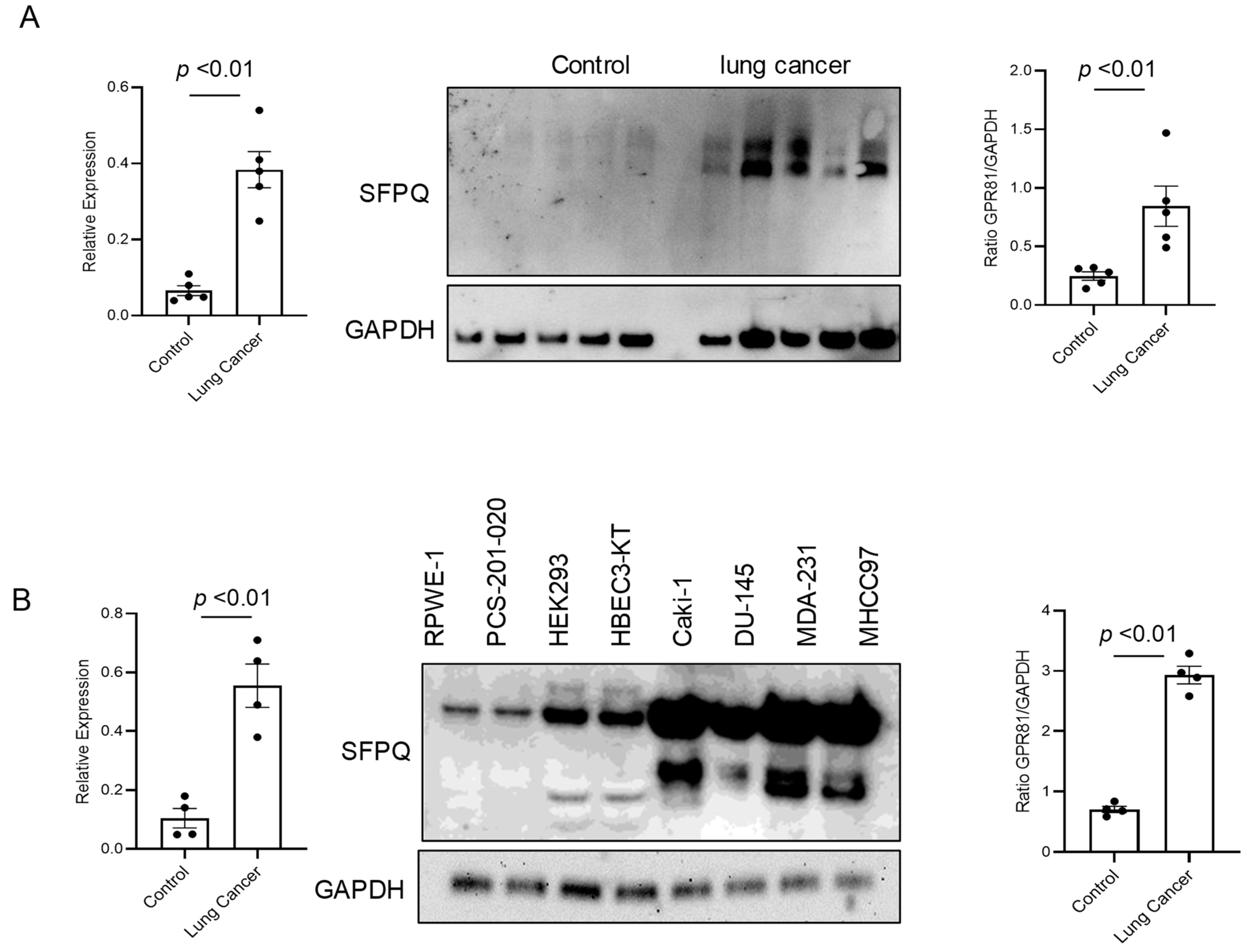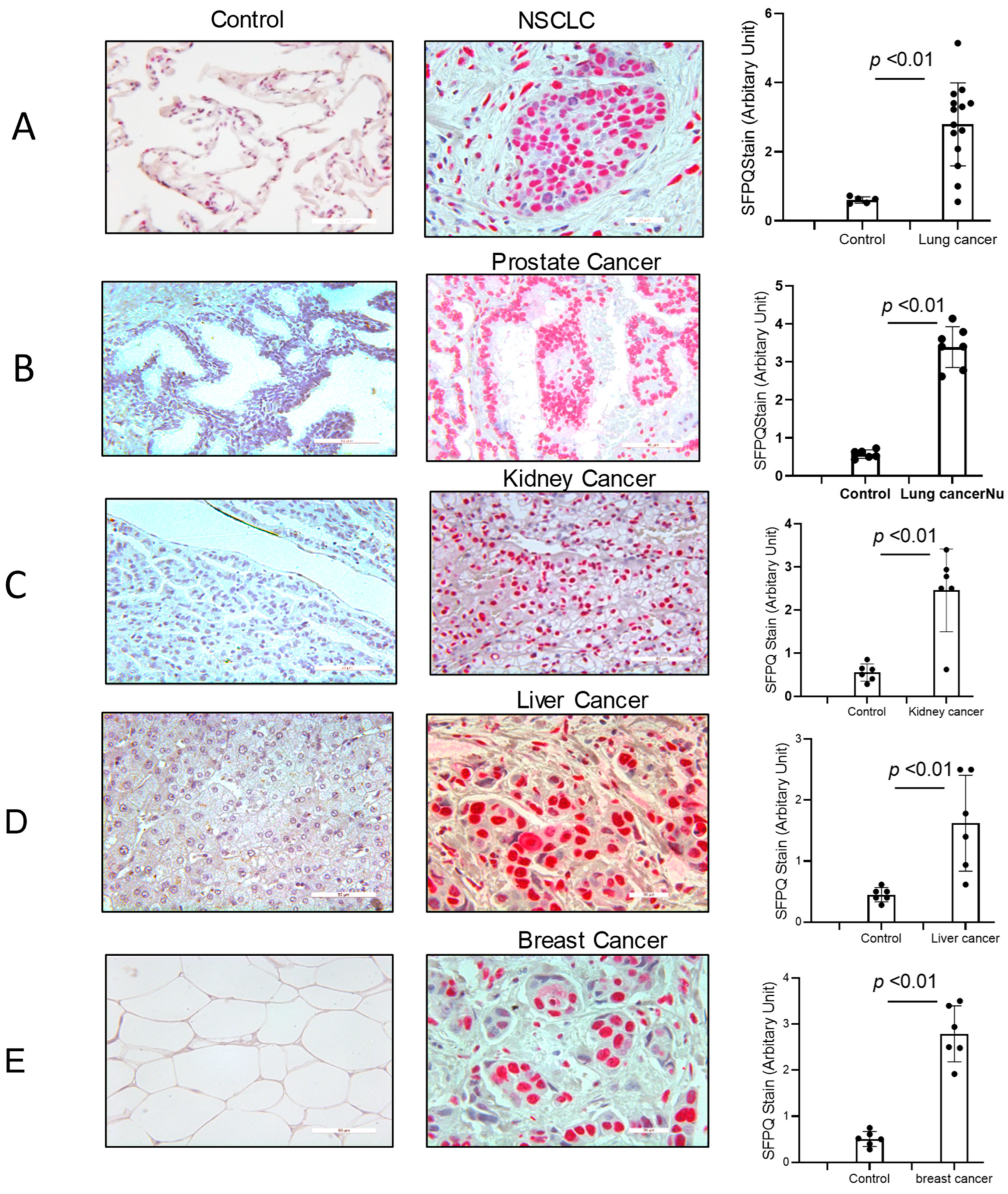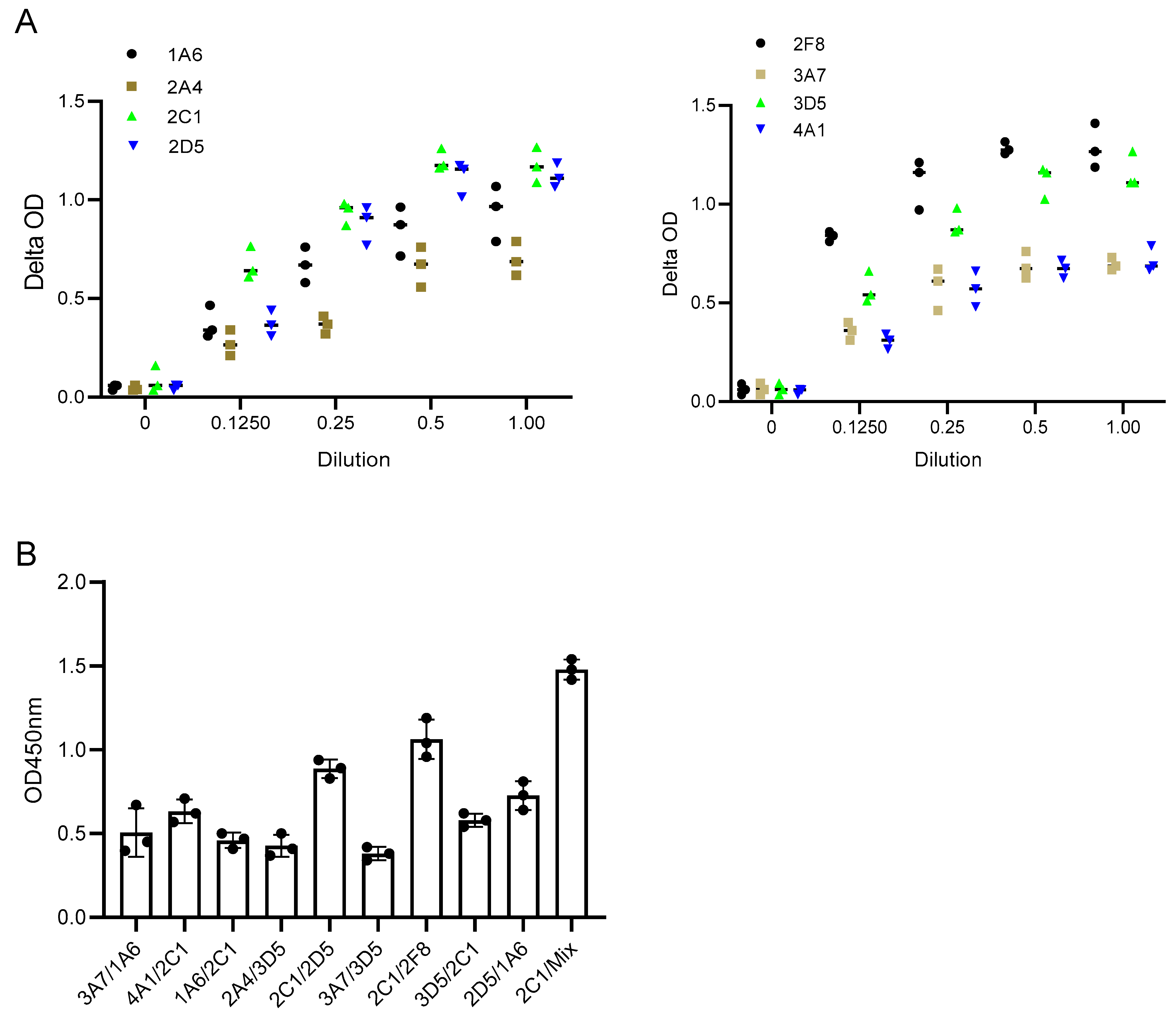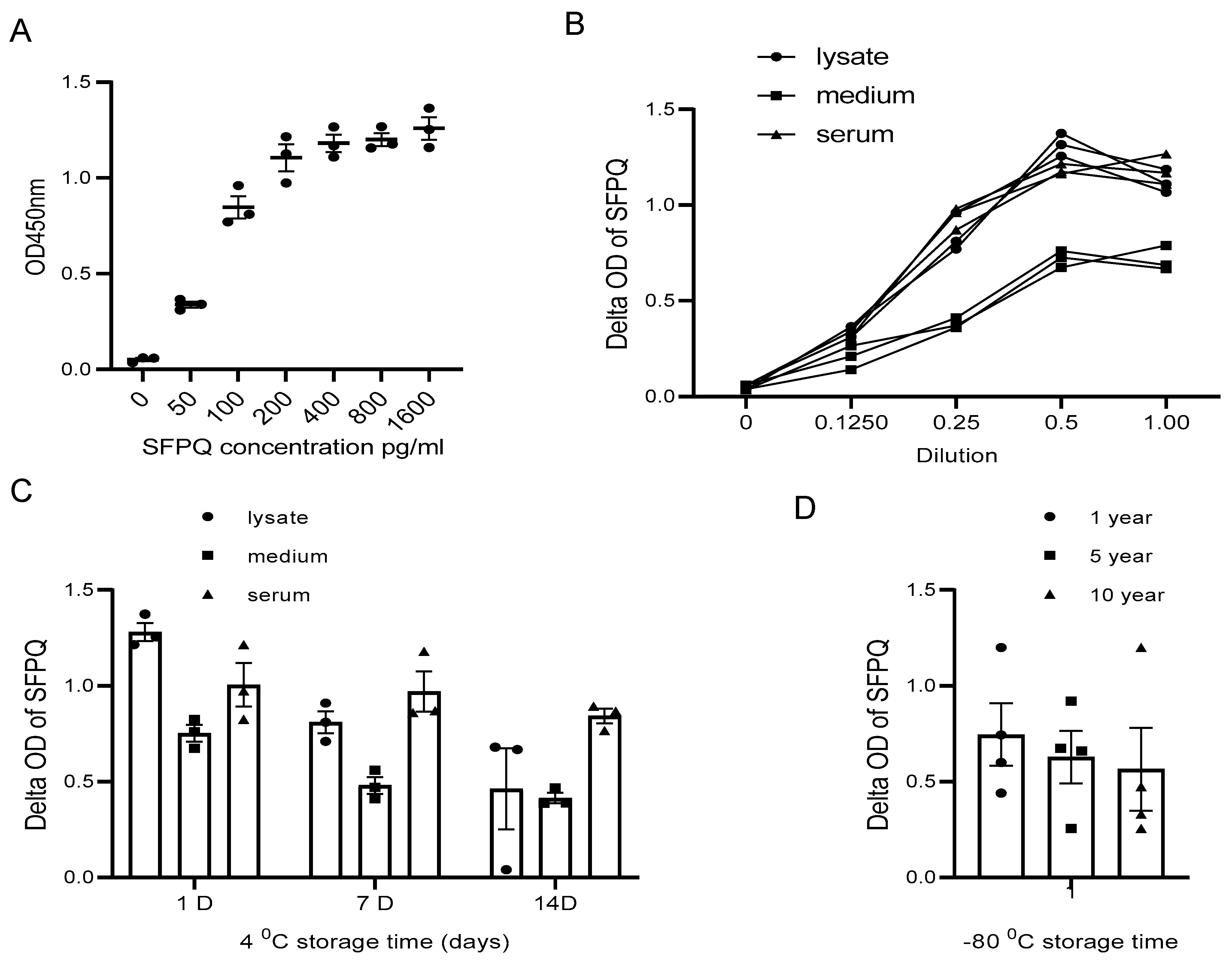Serum Splicing Factor Proline- and Glutamine-Rich Is a Diagnostic Marker for Non-Small-Cell Lung Cancer and Other Solid Cancers
Abstract
:1. Introduction
2. Results
2.1. Identification of SFPQ as a Candidate Diagnostic Biomarker in Solid Cancers
2.2. Monoclonal Antibodies Specific for SFPQ
2.3. SFPQ/mAbs Evaluation for ELISA Development
2.4. Serum Collection from Patients with Cancer and Other Donors
2.5. Patient Characteristics
3. Discussion
4. Materials and Methods
4.1. Monoclonal Antibodies Specific for SFPQ
4.2. mAb Biotinylation
4.3. SFPQ and SFPQ Antibody Purification
4.4. Development of the Sandwich ELISA Test to Detect SFPQ
4.5. Cell Culture
4.6. Serum Collection from Patients with Cancer and Other Donors
Author Contributions
Funding
Institutional Review Board Statement
Informed Consent Statement
Data Availability Statement
Acknowledgments
Conflicts of Interest
References
- Qin, W.; Jiang, F.; Zhang, T. Diagnostic Value of Serum Markers Combined with TVCDS in Ovarian Cancer Patients Treated with Bushen Yiqi Quyu Prescription. Evid.-Based Complement. Altern. Med. 2021, 2021, 3522906. [Google Scholar] [CrossRef] [PubMed]
- Wu, X.; Lu, X.H.; Xu, T.; Qian, J.M.; Zhao, P.; Guo, X.Z.; Yang, X.; Jiang, W.J. Evaluation of the diagnostic value of serum tumor markers, and fecal k-ras and p53 gene mutations for pancreatic cancer. Chin. J. Dig. Dis. 2006, 7, 170–174. [Google Scholar] [CrossRef] [PubMed]
- Zhu, D.; Wang, J.; Ren, L.; Li, Y.; Xu, B.; Wei, Y.; Zhong, Y.; Yu, X.; Zhai, S.; Xu, J.; et al. Serum proteomic profiling for the early diagnosis of colorectal cancer. J. Cell Biochem. 2013, 114, 448–455. [Google Scholar] [CrossRef]
- Nagpal, M.; Singh, S.; Singh, P.; Chauhan, P.; Zaidi, M.A. Tumor markers: A diagnostic tool. Natl. J. Maxillofac. Surg. 2016, 7, 17–20. [Google Scholar] [PubMed]
- Perkins, G.L.; Slater, E.D.; Sanders, G.K.; Prichard, J.G. Serum tumor markers. Am. Fam. Physician 2003, 68, 1075–1082. [Google Scholar]
- Buresova, M.; Benesova, L.; Minarik, M.; Ptackova, R.; Halkova, T.; Hosek, P.; Baxa, J.; Pesek, M.; Svaton, M.; Fiala, O. Circulating Tumor DNA correlates with Lactate Dehydrogenase, CYFRA 21-1, and CRP levels in patients with advanced NSCLC. J. Cancer 2023, 14, 1–8. [Google Scholar] [CrossRef] [PubMed]
- Guo, S.; Chen, J.; Hu, P.; Li, C.; Wang, X.; Chen, N.; Wu, S. The Value of Circulating Tumor Cells and Tumor Markers Detection in Lung Cancer Diagnosis. Technol. Cancer Res. Treat. 2023, 22, 15330338231166754. [Google Scholar] [CrossRef] [PubMed]
- Schneider, J. Tumor markers in detection of lung cancer. Adv. Clin. Chem. 2006, 42, 1–41. [Google Scholar]
- Trape, J.; Perez de Olaguer, J.; Buxo, J.; Lopez, L. Biological variation of tumor markers and its application in the detection of disease progression in patients with non-small cell lung cancer. Clin. Chem. 2005, 51, 219–222. [Google Scholar] [CrossRef]
- Stagsted, L.V.W.; O’Leary, E.T.; Ebbesen, K.K.; Hansen, T.B. The RNA-binding protein SFPQ preserves long-intron splicing and regulates circRNA biogenesis in mammals. Elife 2021, 10, e63088. [Google Scholar] [CrossRef]
- Taylor, R.; Hamid, F.; Fielding, T.; Gordon, P.M.; Maloney, M.; Makeyev, E.V.; Houart, C. Prematurely terminated intron-retaining mRNAs invade axons in SFPQ null-driven neurodegeneration and are a hallmark of ALS. Nat. Commun. 2022, 13, 6994. [Google Scholar] [CrossRef] [PubMed]
- Widagdo, J.; Udagedara, S.; Bhembre, N.; Tan, J.Z.A.; Neureiter, L.; Huang, J.; Lee, M. Familial ALS-associated SFPQ variants promote the formation of SFPQ cytoplasmic aggregates in primary neurons. Open Biol. 2022, 12, 220187. [Google Scholar] [CrossRef] [PubMed]
- Gordon, P.M.; Hamid, F.; Makeyev, E.V.; Houart, C. A conserved role for the ALS-linked splicing factor SFPQ in repression of pathogenic cryptic last exons. Nat. Commun. 2021, 12, 1918. [Google Scholar] [CrossRef]
- Klotz-Noack, K.; Klinger, B.; Rivera, M.; Bublitz, N.; Uhlitz, F.; Riemer, P.; Sers, C. SFPQ Depletion Is Synthetically Lethal with BRAF(V600E) in Colorectal Cancer Cells. Cell Rep. 2020, 32, 108184. [Google Scholar] [CrossRef]
- Kok, V.J.T.; Tang, J.Y.; Eng, G.W.L.; Tan, S.Y.; Chin, J.T.F.; Quek, C.H.; Lai, W.X.; Lim, T.K.; Lin, Q.; Chua, J.J.E.; et al. SFPQ promotes RAS-mutant cancer cell growth by modulating 5’-UTR mediated translational control of CK1alpha. NAR Cancer 2022, 4, zcac027. [Google Scholar] [CrossRef] [PubMed]
- Yang, L.; Yang, J.; Jacobson, B.; Gilbertsen, A.; Smith, K.; Higgins, L.; Guerrero, C.; Xia, H.; Henke, C.A.; Lin, J. SFPQ Promotes Lung Cancer Malignancy via Regulation of CD44 v6 Expression. Front. Oncol. 2022, 12, 862250. [Google Scholar] [CrossRef]
- Yang, L.; Gilbertsen, A.; Jacobson, B.; Pham, J.; Fujioka, N.; Henke, C.A.; Kratzke, R.A. SFPQ and Its Isoform as Potential Biomarker for Non-Small-Cell Lung Cancer. Int. J. Mol. Sci. 2023, 24, 12500. [Google Scholar] [CrossRef]
- Holzlohner, P.; Hanack, K. Generation of Murine Monoclonal Antibodies by Hybridoma Technology. J. Vis. Exp. 2017, 119, e54832. [Google Scholar]
- Abhyankar, A.V.; Bhargava, R.; Jana, A.M.; Sahni, A.K.; Rao, P.V. Production and characterization of monoclonal antibody specific to recombinant dengue multi-epitope protein. Hybridoma 2008, 27, 191–198. [Google Scholar] [CrossRef] [PubMed]
- Kim, H.Y.; Stojadinovic, A.; Izadjoo, M.J. Immunization, Hybridoma Generation, and Selection for Monoclonal Antibody Production. In Monoclonal Antibodies; Ossipow, V., Fischer, N., Eds.; Humana Press: Totowa, NJ, USA, 2014; pp. 33–45. [Google Scholar]
- Holdenrieder, S.; Pagliaro, L.; Morgenstern, D.; Dayyani, F. Clinically Meaningful Use of Blood Tumor Markers in Oncology. Biomed. Res. Int. 2016, 2016, 9795269. [Google Scholar] [CrossRef]
- Gao, Y.; Wang, J.; Zhou, Y.; Sheng, S.; Qian, S.Y.; Huo, X. Evaluation of Serum CEA, CA19-9, CA72-4, CA125 and Ferritin as Diagnostic Markers and Factors of Clinical Parameters for Colorectal Cancer. Sci. Rep. 2018, 8, 2732. [Google Scholar] [CrossRef] [PubMed]
- Kawa, S.; Kato, M.; Oguchi, H.; Hsue, G.L.; Kobayashi, T.; Koiwai, T.; Tokoo, M.; Furuta, S.; Ichikawa, T.; Kanai, M. Clinical evaluation of pancreatic cancer-associated mucin expressing CA19-9, CA50, Span-1, sialyl SSEA-1, and Dupan-2. Scand. J. Gastroenterol. 1992, 27, 635–643. [Google Scholar] [CrossRef] [PubMed]
- Rayner, S.L.; Cheng, F.; Hogan, A.L.; Grima, N.; Yang, S.; Ke, Y.D.; Au, C.G.; Morsch, M.; De Luca, A.; Davidson, J.M.; et al. ALS/FTD-causing mutation in cyclin F causes the dysregulation of SFPQ. Hum. Mol. Genet. 2021, 30, 971–984. [Google Scholar] [CrossRef] [PubMed]
- Zhang, D.G.; Jiang, A.G.; Lu, H.Y.; Zhang, L.X.; Gao, X.Y. Isolation, cultivation and identification of human lung adenocarcinoma stem cells. Oncol. Lett. 2015, 9, 47–54. [Google Scholar] [CrossRef]






| Disease | Case Number | Gender | Cancer Stage | SFPQ (ng/mL) | Stdev |
|---|---|---|---|---|---|
| Non-Cancer | 19 | M:12; F7 | 12.47 | 17.3 | |
| NSCLC (Lung cancer) | 46(52) | M:32(4),F:14(2) | II:13,III:16,IV:17 | 70.96 | 36.25 |
| Kidney Cancer | 15 | M:8, F:7 | II:2,III:8,IV:5 | 66.84 | 47.03 |
| Prostate Cancer | 12 | M:15 | II:3,III:6,IV:3 | 53.27 | 44.9 |
| Liver Cancer | 9 | M6,F3 | II:1,III:4,IV:4 | 80.16 | 41.44 |
| Breast Cancer | 18 | M:1, F17 | II:3,III:11,IV:4 | 50.27 | 44.3 |
| Thyroid Cancer | 7 | M:2,F5 | II:1,III:1,IV:2,V:2,VI:1 | 61.35 | 48.4 |
Disclaimer/Publisher’s Note: The statements, opinions and data contained in all publications are solely those of the individual author(s) and contributor(s) and not of MDPI and/or the editor(s). MDPI and/or the editor(s) disclaim responsibility for any injury to people or property resulting from any ideas, methods, instructions or products referred to in the content. |
© 2024 by the authors. Licensee MDPI, Basel, Switzerland. This article is an open access article distributed under the terms and conditions of the Creative Commons Attribution (CC BY) license (https://creativecommons.org/licenses/by/4.0/).
Share and Cite
Yang, L.; Gilbertsen, A.; Jacobson, B.; Kratzke, R.; Henke, C.A. Serum Splicing Factor Proline- and Glutamine-Rich Is a Diagnostic Marker for Non-Small-Cell Lung Cancer and Other Solid Cancers. Int. J. Mol. Sci. 2024, 25, 8766. https://doi.org/10.3390/ijms25168766
Yang L, Gilbertsen A, Jacobson B, Kratzke R, Henke CA. Serum Splicing Factor Proline- and Glutamine-Rich Is a Diagnostic Marker for Non-Small-Cell Lung Cancer and Other Solid Cancers. International Journal of Molecular Sciences. 2024; 25(16):8766. https://doi.org/10.3390/ijms25168766
Chicago/Turabian StyleYang, Libang, Adam Gilbertsen, Blake Jacobson, Robert Kratzke, and Craig A. Henke. 2024. "Serum Splicing Factor Proline- and Glutamine-Rich Is a Diagnostic Marker for Non-Small-Cell Lung Cancer and Other Solid Cancers" International Journal of Molecular Sciences 25, no. 16: 8766. https://doi.org/10.3390/ijms25168766





